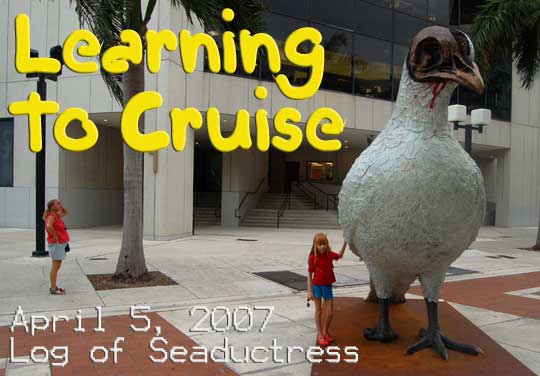
Back in the USA! You know you're back in America when you encounter a fifteen foot tall statue of a pigeon with blood dripping from his neck in the streets. Miami, I love your style.
April 6, 2007 - Boot Key Harbor
The ease of just going to a store and buying whatever you like (even if you have to walk there or take a cab) is still a bit of a novelty to us, but that won't last. We motored in here to Boot Key a couple of days ago, stopping for 17 gallons of diesel and ice cream at Burdines, and got a mooring in the city's expanded mooring field.
 Moorings are $18/night, not including use of the dinghy dock. This time of year, the harbor is far less crowded and there was plenty of room to anchor at the southern end of the harbor, but it's nice to be on a ball when the winds blow.
Moorings are $18/night, not including use of the dinghy dock. This time of year, the harbor is far less crowded and there was plenty of room to anchor at the southern end of the harbor, but it's nice to be on a ball when the winds blow.
We've been to Home Depot, K-Mart, Publix, West Marine, and the library so far. Yesterday Laura and I took the dinghy up Sisters Creek to the beach out on the ocean side, and discovered a very nice beach, park, and playground. Today we wanted to visit the Natural History Museum but it's raining and they are probably closed because it's Good Friday. We have most of our chores completed now, so we're just waiting for good weather to jump over to Key West and perhaps the Dry Tortugas.
Photo: Some things, like when Laura loses a baby tooth, get more complicated on a boat. For example, does the tooth fairy have to pay a dinghy dock fee, and if so, is that deducted from the amount left under the pillow?
April 8, 2007 - Newfound Harbor
We're anchored tonight about 20 miles from Key West after a short day of travel from Boot Key Harbor. We left about Noon today after a successful Easter Egg hunt with some of the other kids from the harbor. I had asked at the city marina if they knew of any Easter activities for the kids, and before you knew it, a hunt was organized.
Last year it seemed that we spent most of our five days in Marathon doing chores or working on the boat. This time we were able to spend a more time exploring. We especially enjoyed the park at Sombrero Beach and the Crane Point Museum and Nature Center. I can see why so many people spend the entire season in Boot Key. There's a good feeling to the place that starts with the friendly bridge tender at the Boot Key Bridge and carries throughout your visit. "Hope to see you again soon," the bridge tender said as we departed. I hope so, too.
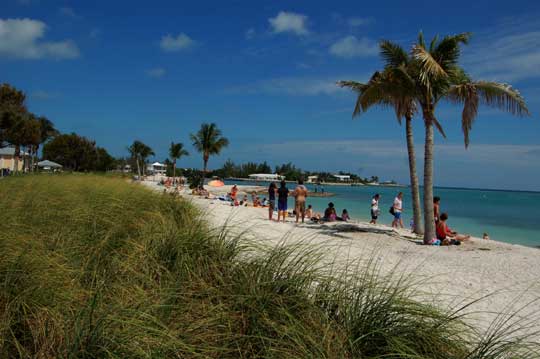
Photo: Sombrero Beach is very nice, with an excellent city park and playground. We dinghied there via Sisters Creek, not sure if a sign that read "No boat mooring allowed" on a dock meant that we weren't supposed to leave our dinghy near the beach--but both times we visited we had no problem.
April 9, 2007 - Key West
Annie and I have a history of arriving in Key West, then leaving without seeing much of it. We've never stepped inside Sloppy Joe's, Captain Tony's, or any other bar here, which some would say means we've never been to Margaritaville at all. This time, our first visit by water, we immediately got confused about where to put the boat. Both the Waterway Guide and Skipper Bob said the city mooring field was in Man of War Harbor, clearly marked on the chart west of Fleming Key. We picked up a dilapidated mooring ball, supplying our own pendant as advertised, but this didn't look like a maintained mooring field, even for the laid-back town of Key West. Sure enough, we eventually figured out that the mooring field was on the east side of Fleming in Garrison Bay. We stayed on the ball we'd picked up until evening, when a fellow came by and said the chain holding it was in terrible shape. We ended up anchored nearby.
We dinghied in to the dock at Kraal's Turtle Restaurant ($5.50/day) and walked Duval Street on our way to the post office. It seemed very fitting to be filing IRS form 4868 (application to extend tax deadline) from Key West.
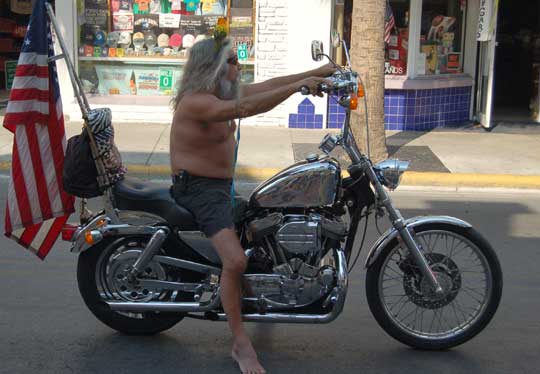
Photo: This picture, for me, nicely sums up Key West: a barefoot, bare chested and apparently patriotic resident rides his Harley down Duval Street with a live bird sitting on his head while all of us tourists pretend we see this kind of thing at home all the time.
April 10, 2007 - Key West
Determined to get an early start and see all the sights, we set off in early afternoon for town. First stop: B.O.'s Fish Wagon, which Key West Expert Tim Farmer had told us via a telephone interdiction was the home of the best fish sandwich in the world. It was good, all right. Next we made our way to Mallory Square, where we encountered a sculpture garden that was strikingly similar to the one in Green Turtle Cay, Bahamas. In fact, a sign explained that the garden here was modeled on the one in Green Turtle. The layout was a little different and there were chickens running all over the place (I'm not clear why there are so many free-ranging roosters and chickens in Key West, but they are particularly thick around Mallory Square). We spent a couple of hours at the Key West Aquarium, at least an hour of that at the touch tank where Laura touched every animal at least twice.
Next we walked to the famous Key West Cemetery. We searched for quite a while, but could not find the headstone for E. Larez, "devoted fan of Julio Ingleses." There are 75,000 people buried there, so perhaps we didn't give it enough time. We still hadn't taken a picture at the "southernmost spot," ridden the Conch Tour Train, or picked up the bar of gold at the Mel Fisher museum, or even attended the daily sunset party at Mallory Square, but the girls were tired so we made an early night of it and headed home. Tomorrow if the weather holds we'll be up early for the 68 mile journey out to the Try Tortugas.
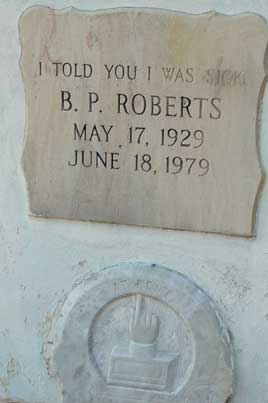

Photos: (1) "I told you I was sick!" We did manage to locate the most visited headstone in Key West...this guy is said to be a hypochondriac who had the last word. (2) Deep into the Catholic part of the cemetery, we came across this grave site flamingo. All of these cemetery icons have meanings, but I can't seem to find what a flamingo would designate--unless it just means you're buried in Key West.
April 12, 2007 - Dry Tortugas
We went to bed yesterday evening planning on an early start for the Dry Tortugas. At 3:00 AM, the boat started moving, but unfortunately we were still anchored. A squall with at least forty knot winds came through, and although we stood firm for the first fifteen minutes or so, eventually our Delta anchor (evidently not set in the sand it prefers) pulled up stakes and headed south. With another line of storms lurking in our path, I talked the boat into staying put another day in Key West. This worked out fine as we were able to tour the Truman "Little White House" and see some of the acts at the daily Sunset Celebration at Mallory Square. We saw a 61 year old acrobat walk a tightrope, watched a guy swallow a 25 inch sword, another guy escape from chains and straitjacket, and witnessed a fourth guy juggling a chain saw, sword, and hand grenade. Although we never did make it to the southernmost point of the United States on this trip, we did see a performance by the southernmost bagpipe player.
This morning we left the anchorage at 6:00 AM, well before sunup, in hopes of having some time to explore the Dry Tortugas this afternoon. We had a favorable breeze and were making good time until we got just south of the Marquesas. The good news was that we caught a nice mackerel, actually the second one we've caught using the excellent lures that Robert brought us last month. I had to filet the fish quickly, since the bad news was a nasty squall line bearing down on us. With a double-reefed main we plowed into 30 knots of wind and four foot waves for about an hour. Why do the storm winds always come from the wrong direction? Never again, my friend, would the winds on this day blow favorably. The fishing remained exciting, as we hooked two more mackerel (they call this water "mackerel alley") and what looked like a nice tuna, but darn if all three didn't get away from us.
When we finally tooled into the anchorage in front of Fort Jefferson after eleven hours of travel, it was like arriving at the Magic Kingdom. Tens of thousands of sooty terns were swarming all over Bush Key like locusts. A gigantic spotted eagle ray went by below us, and soon four of the biggest grouper I have ever seen--these guys looked like manatees--came over to hang out under the boat and see if we were careless enough to drop any food. We're looking forward to exploring the immense fort tomorrow, and then will probably boogie out of here in the evening, headed for Everglades City.
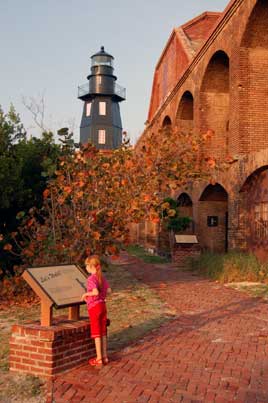
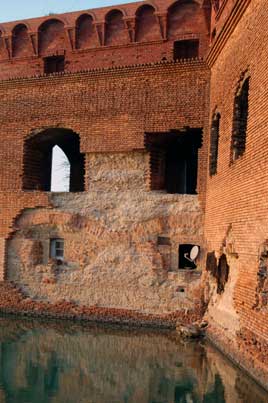
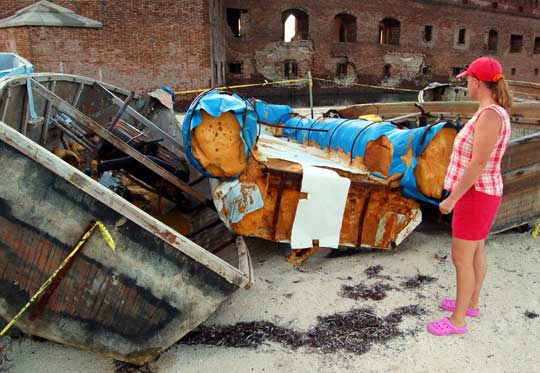
Photos: (1) This is far inside the fort as we got today, but it's a huge space in there. You could fit two or three regular fortresses inside Fort Jefferson. (2) Amid the decaying walls, can you spot the thing that doesn't quite fit? (3) Several home-made Cuban refugee boats, one of them only a couple of months old, are pulled up on the beach near the fort. The boats, typically powered by an old car engine, generally carry about 10 to 15 people. If they make it to ashore, they can stay.
April 14, 2007 - Everglades City
Although we stayed only one day, the Dry Tortugas were well worth a stop. Fort Jefferson, covering virtually all of Garden Key, is simply amazing in its scale and scope. The fort was designed to have 420 heavy cannon, with a goal of being able to aim up to 125 of them at a single target. The largest guns, 15 inch Rodman smoothbores, weighed 25 tons each and could hurl a 400 pound projectile three miles. The sheer weight of 16 million bricks caused the walls to sink into the sand; many of the 109 cisterns holding 1.5 million gallons of water cracked and filled with salt water. Thirty years of construction went by, yellow fever epidemics and hurricanes swept the fort, and like many other military projects, the fort became obsolete before it was ever completed.
We were pleasantly surprised by the snorkeling at the old coal piers, where we truthfully saw the most fish we have ever seen in one place. They were all the same fish (two inch fry of some sort) but we estimated there were 10-12 million of them in that one acre area. They were so thick in places that you could barely see the bottom.
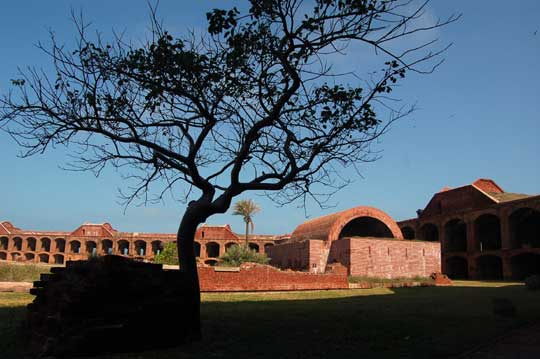
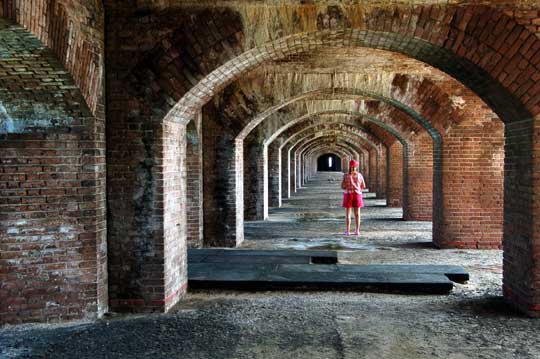
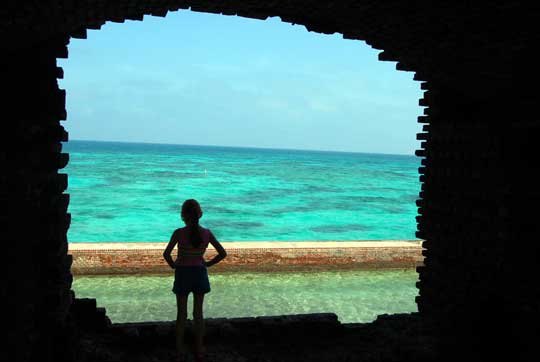
Photos: (1) Just a portion of the huge parade grounds inside the walls. The arched structure at right was the main powder magazine. (2) Between every one of these arches was to be a cannon, and this is just a small section of the bottom of three tiers. (3) Most of the second tier openings were never completed due to concerns over the fort sinking. You can see the moat wall out in front of the fort.
After a last-minute bulb change for the bow lights, we pulled anchor and motored away from Fort Jefferson around 7:30 PM. It was a long bash to windward, but 18 hours later we arrived in Everglades City and tied up to the dock at City Seafood just behind Living Well. Steve and Gloria treated us to a delicious dinner at the Cafe upstairs, and we enjoyed spending the evening with Peter, Monika, and Glaudia (if I'm spelling that right) of Taua, a wonderful 40 foot steel boat out of Brazil that Peter has turned into a true cruising machine. Taua draws 3 1/2 feet with the hydraulic centerboard up and can be beached. Being around this friendly and engaging family really makes you feel like a dumb American. I can only speak one language, can't make a paper airplane that flies as good as Glaudia's, and couldn't mold a part out of epoxy for a winch from scratch like Peter did to save my life.
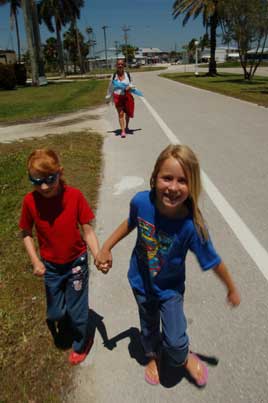


Photos: (1) Laura and Glaudia had a fabulous time together. Here we are walking through the metropolis of Everglades City to the playground. (2) Among other things, Glaudia knows a lot about fishing! Here she and Laura fish (both successfully, I should add) in front of City Seafood. (3) Glaudia's parents Peter and Monika (Taua) with their friend Jean (Doxie) enjoy their meal at the City Seafood Cafe. Steve and Gloria from Living Well are the chef and hostess for this fine establishment.
April 17, 2007 - Marco Island
We just anchored in the company of three trawlers and five other sailboats in Factory Bay at Marco Island. This place is infamous because of the city's anchoring ordinance, which states, among other things, that boats cannot be closer than 300 feet to shore and must be pumped out every three days. Even boats anchored within those parameters are allegedly subject to harassment in the form of daily or even more frequent "safety checks." In January, Marco Island resident David Dumas deliberately anchored his 42-foot trawler Kinship close to shore and was arrested in an act of civil disobedience. According to Claiborne Young's Salty Southeast newsletter, the trial should be sometime in April or May.
Last year the State of Florida prohibited local governments from regulating the anchoring of "non-live-aboard" vessels except in mooring fields (most cruisers are not "live-aboards" in the sense of this law). The Marco Island law seems in direct conflict with the state law as well as federal rules about navigable waters. Word is that the city based their law on a similar one in Clearwater which had been upheld earlier by the Florida courts. They probably don't want to talk about the fact that Clearwater has now dropped their ordinance in order to comply with the state law. All of this makes for an interesting place to visit, although I would have to be hard-pressed to spend a dollar in this town due to their anti-cruiser regulations.
It's always difficult for me to leave a friendly port. It was especially difficult to leave Everglades City this morning. Old friends and new were on the dock to see us off, perhaps for the last time, and I felt like a fool for leaving this wonderful place. Still, we knew were nearing the midpoint of a falling tide so there was no time to delay. Alas, we had not realized that the tide in Everglades City is almost three hours behind the tide at Indian Key. We hit bottom twice in the middle of the channel at the west end of Chokoloskee Bay, but plowed through and thought we had it made...until we reached marker 18. We tried three times to get past the rising bottom, escaping the final attempt only with several minutes of wiggling the boat back and forth in the mud. Fortunately, there was a spot just east of the marker where we could get out of the channel and wait for more favorable conditions. For our 5 1/2 foot draft, you really do want mid-tide or better for this channel!
By Noon we were on the move again, motoring out in the Gulf. The forecast wasn't good, but the reality was worse. By the time had gone ten miles out to get around Cape Romano shoal, the wind was a solid 15-18 knots almost on the nose with four foot seas. I radioed Towboat U.S. for local information and was advised not to attempt the inland waterway north of Marco at low tide, so we headed for Factory Bay. Just to make things more interesting, Capri Pass gave us just six feet of water (that's six inches under the keel) in a couple of spots, with all those swells breaking around us. I had no idea this pass was so shallow, which turned out to be a good thing. Otherwise, we might still be out there bouncing around.
Interesting statistics on our cruise so far: in 581 days we have anchored 173 times, taken 21 moorings, gone into a marina or free dock 46 times, and made 16 overnight passages, the longest of them a two-night journey of around 240 miles. Based on the hours recorded by the autopilot (which has done 99.9% of the steering and now seems to have problems in the fluxgate compass), we have spent around 1360 hours underway.
April 18, 2007 - Cayo Costa Island, Charlotte Harbor
By 7:00 this morning, every boat (including us) was gone from Factory Bay. Evidently few cruisers want to linger around Marco Island these days. We had an uneventful 50 mile motorsail up the Gulf to Charlotte Harbor, where we anchored off Caya Costa Island. Unfortunately, our Raymarine autopilot has been acting up...this is why I had problems with the heading being off near Bimini on our overnight to Miami. If we make any sharp turns, the fluxgate compass apparently gets confused and can't track. Sometimes the pilot will still steer; other times it says "no data" and goes back to standby mode (although it still displays the heading, however wrong it might be, and the rudder position and other data). I checked the cables and everything looked good. Peter on Taua had a similar problem that turned out to be a broken connection in the flat cable in the compass. I'm going to try to contact Raymarine and see what they say.

